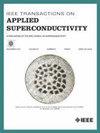AC Loss Measurements at High B, dB/dt for ReBCO Tape Stacks With Various Values of Tape Separation and Loss in Helically Wound Cables
IF 1.7
3区 物理与天体物理
Q3 ENGINEERING, ELECTRICAL & ELECTRONIC
引用次数: 0
Abstract
The demand for high-power motors and generators for electric aircraft requires conductors with performance above that of ambient temperature Cu and Al. High current density superconducting Re-Ba-Cu-O (ReBCO) conductors and cables are of interest, but AC loss characterization under relevant excitation is needed. In this work, we explored the AC losses of ReBCO tapes, tape stacks, and round (CORC) cables at aircraft motor/generator relevant fields and frequencies. The measurements were performed using a previously described Spinning-Magnet-Calorimeter (SMC), where a superconducting sample is placed in an LN2 bath and exposed to the magnetic fields of a spinning magnetic Halbach array. In this system, loss is measured using a calorimetric method (measuring the LN2 boil off). Previous work has shown a significant shielding effect with higher numbers of ReBCO tapes in a stack. This present work looks at the reduction of this shielding with increased tape-to-tape separation distance in stacked tape samples. This work also explored loss in CORC cables with different numbers of layers, and compared the loss per tapes for CORC conductors with different numbers of layers (and with both striated and unstriated tapes). The magnitude of the shielding as a function of layers is compared for the two conductors.在高B、dB/dt条件下,螺旋缠绕电缆中具有不同带分离和损耗值的ReBCO带堆的交流损耗测量
电动飞机对大功率电机和发电机的需求要求导体的性能高于环境温度下的铜和铝。高电流密度超导 Re-Ba-Cu-O (ReBCO) 导体和电缆备受关注,但需要在相关激励下进行交流损耗表征。在这项工作中,我们探索了 ReBCO 磁带、磁带堆叠和圆形 (CORC) 电缆在飞机电机/发电机相关场和频率下的交流损耗。测量是使用之前描述过的旋转磁场量热计(SMC)进行的,将超导样品置于 LN2 浴中,并暴露在旋转磁场哈尔巴赫阵列的磁场中。在该系统中,损耗是通过量热法(测量 LN2 沸腾)测量的。先前的工作表明,堆栈中 ReBCO 磁带数量越多,屏蔽效果越明显。目前的工作研究的是随着堆叠磁带样品中磁带与磁带之间分离距离的增加,屏蔽效果会降低。这项研究还探讨了不同层数 CORC 电缆的损耗,并比较了不同层数 CORC 导体(以及有条纹和无条纹带)的每带损耗。还比较了两种导体的屏蔽程度与层数的函数关系。
本文章由计算机程序翻译,如有差异,请以英文原文为准。
求助全文
约1分钟内获得全文
求助全文
来源期刊

IEEE Transactions on Applied Superconductivity
工程技术-工程:电子与电气
CiteScore
3.50
自引率
33.30%
发文量
650
审稿时长
2.3 months
期刊介绍:
IEEE Transactions on Applied Superconductivity (TAS) contains articles on the applications of superconductivity and other relevant technology. Electronic applications include analog and digital circuits employing thin films and active devices such as Josephson junctions. Large scale applications include magnets for power applications such as motors and generators, for magnetic resonance, for accelerators, and cable applications such as power transmission.
 求助内容:
求助内容: 应助结果提醒方式:
应助结果提醒方式:


